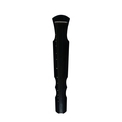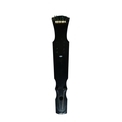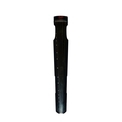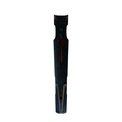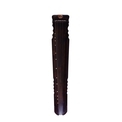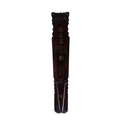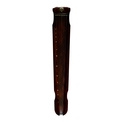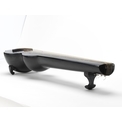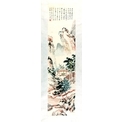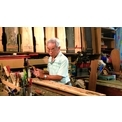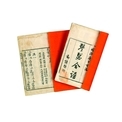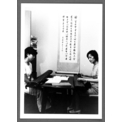Reformed Qin in the Form of a Guitar (2)
This qin was made by the late Cheung Sai-bung, a music scholar in Hong Kong. It bears the following characteristics:1. The body is enlarged to increase the amplitude of the sound and references a guitar design.
2. Unlike a traditional qin that features two sound holes on the bottom, the only sound hole existent in this case is on the top.
3. The traditional tuning peg system has been replaced by a guitar machine head.
4. The strings are attached to seven metal knobs on the tail, thus obviating the need to fix the strings on the feet.
5. There are three supporting feet on the bottom.
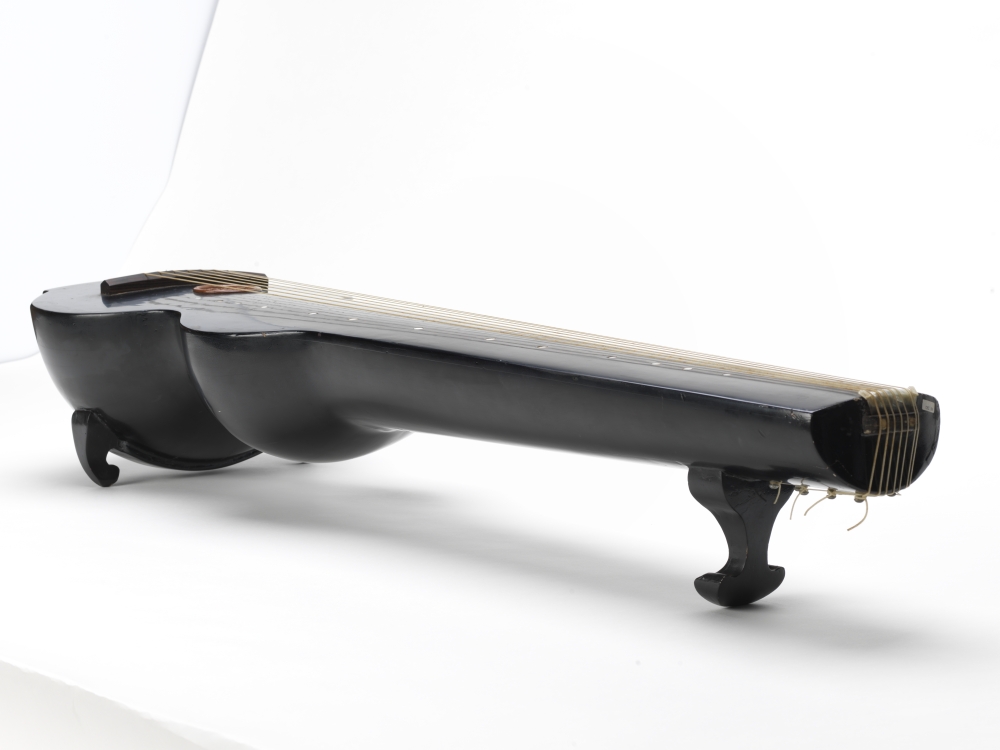
| Date | 1960s |
| Object | Musical instrument |
| Material Type | Image |
| Collection | The Legend of Silk and Wood: A Hong Kong Qin Story |
| Source | Courtesy of Chinese Music Archive of Department of Music of The Chinese Univeristy of Hong Kong |
| Repository | Chinese Music Archive, Department of Music, The Chinese University of Hong Kong |
| Note to Copyright | Permission for use in Hong Kong Memory is given by Department of Music of the Chinese University of Hong Kong |
| Accession No. | lcs-hkqs-0019 |
Reformed Qin in the Form of a Guitar (2)
This qin was made by the late Cheung Sai-bung, a music scholar in Hong Kong. It bears the following characteristics:1. The body is enlarged to increase the amplitude of the sound and references a guitar design.
2. Unlike a traditional qin that features two sound holes on the bottom, the only sound hole existent in this case is on the top.
3. The traditional tuning peg system has been replaced by a guitar machine head.
4. The strings are attached to seven metal knobs on the tail, thus obviating the need to fix the strings on the feet.
5. There are three supporting feet on the bottom.

| Date | 1960s |
| Style | Reformed qin in the form of a guitar |
| Size | Length (Whole 125cm, Strings 108cm); Widest surface 40cm; Thickness 25 cm |
| Object | Musical instrument |
| Material Type | Image |
| Collection | The Legend of Silk and Wood: A Hong Kong Qin Story |
| Source | Courtesy of Chinese Music Archive of Department of Music of The Chinese Univeristy of Hong Kong |
| Repository | Chinese Music Archive, Department of Music, The Chinese University of Hong Kong |
| Note to Copyright | Permission for use in Hong Kong Memory is given by Department of Music of the Chinese University of Hong Kong |
| Accession No. | lcs-hkqs-0019 |
Reformed Qin in the Form of a Guitar (2)
This qin was made by the late Cheung Sai-bung, a music scholar in Hong Kong. It bears the following characteristics:1. The body is enlarged to increase the amplitude of the sound and references a guitar design.
2. Unlike a traditional qin that features two sound holes on the bottom, the only sound hole existent in this case is on the top.
3. The traditional tuning peg system has been replaced by a guitar machine head.
4. The strings are attached to seven metal knobs on the tail, thus obviating the need to fix the strings on the feet.
5. There are three supporting feet on the bottom.

| Date | 1960s |
| Object | Musical instrument |
| Material Type | Image |
| Collection | The Legend of Silk and Wood: A Hong Kong Qin Story |
| Source | Courtesy of Chinese Music Archive of Department of Music of The Chinese Univeristy of Hong Kong |
| Repository | Chinese Music Archive, Department of Music, The Chinese University of Hong Kong |
| Note to Copyright | Permission for use in Hong Kong Memory is given by Department of Music of the Chinese University of Hong Kong |
| Accession No. | lcs-hkqs-0019 |
Reformed Qin in the Form of a Guitar (2)
This qin was made by the late Cheung Sai-bung, a music scholar in Hong Kong. It bears the following characteristics:1. The body is enlarged to increase the amplitude of the sound and references a guitar design.
2. Unlike a traditional qin that features two sound holes on the bottom, the only sound hole existent in this case is on the top.
3. The traditional tuning peg system has been replaced by a guitar machine head.
4. The strings are attached to seven metal knobs on the tail, thus obviating the need to fix the strings on the feet.
5. There are three supporting feet on the bottom.

| Date | 1960s |
| Object | Musical instrument |
| Material Type | Image |
| Collection | The Legend of Silk and Wood: A Hong Kong Qin Story |
| Source | Courtesy of Chinese Music Archive of Department of Music of The Chinese Univeristy of Hong Kong |
| Repository | Chinese Music Archive, Department of Music, The Chinese University of Hong Kong |
| Note to Copyright | Permission for use in Hong Kong Memory is given by Department of Music of the Chinese University of Hong Kong |
| Accession No. | lcs-hkqs-0019 |
Reformed Qin in the Form of a Guitar (2)
This qin was made by the late Cheung Sai-bung, a music scholar in Hong Kong. It bears the following characteristics:1. The body is enlarged to increase the amplitude of the sound and references a guitar design.
2. Unlike a traditional qin that features two sound holes on the bottom, the only sound hole existent in this case is on the top.
3. The traditional tuning peg system has been replaced by a guitar machine head.
4. The strings are attached to seven metal knobs on the tail, thus obviating the need to fix the strings on the feet.
5. There are three supporting feet on the bottom.

| Date | 1960s |
| Object | Musical instrument |
| Material Type | Image |
| Collection | The Legend of Silk and Wood: A Hong Kong Qin Story |
| Source | Courtesy of Chinese Music Archive of Department of Music of The Chinese Univeristy of Hong Kong |
| Repository | Chinese Music Archive, Department of Music, The Chinese University of Hong Kong |
| Note to Copyright | Permission for use in Hong Kong Memory is given by Department of Music of the Chinese University of Hong Kong |
| Accession No. | lcs-hkqs-0019 |
Reformed Qin in the Form of a Guitar (2)
This qin was made by the late Cheung Sai-bung, a music scholar in Hong Kong. It bears the following characteristics:1. The body is enlarged to increase the amplitude of the sound and references a guitar design.
2. Unlike a traditional qin that features two sound holes on the bottom, the only sound hole existent in this case is on the top.
3. The traditional tuning peg system has been replaced by a guitar machine head.
4. The strings are attached to seven metal knobs on the tail, thus obviating the need to fix the strings on the feet.
5. There are three supporting feet on the bottom.

| Date | 1960s |
| Object | Musical instrument |
| Material Type | Image |
| Collection | The Legend of Silk and Wood: A Hong Kong Qin Story |
| Source | Courtesy of Chinese Music Archive of Department of Music of The Chinese Univeristy of Hong Kong |
| Repository | Chinese Music Archive, Department of Music, The Chinese University of Hong Kong |
| Note to Copyright | Permission for use in Hong Kong Memory is given by Department of Music of the Chinese University of Hong Kong |
| Accession No. | lcs-hkqs-0019 |
Reformed Qin in the Form of a Guitar (2)
This qin was made by the late Cheung Sai-bung, a music scholar in Hong Kong. It bears the following characteristics:1. The body is enlarged to increase the amplitude of the sound and references a guitar design.
2. Unlike a traditional qin that features two sound holes on the bottom, the only sound hole existent in this case is on the top.
3. The traditional tuning peg system has been replaced by a guitar machine head.
4. The strings are attached to seven metal knobs on the tail, thus obviating the need to fix the strings on the feet.
5. There are three supporting feet on the bottom.

| Date | 1960s |
| Object | Musical instrument |
| Material Type | Image |
| Collection | The Legend of Silk and Wood: A Hong Kong Qin Story |
| Source | Courtesy of Chinese Music Archive of Department of Music of The Chinese Univeristy of Hong Kong |
| Repository | Chinese Music Archive, Department of Music, The Chinese University of Hong Kong |
| Note to Copyright | Permission for use in Hong Kong Memory is given by Department of Music of the Chinese University of Hong Kong |
| Accession No. | lcs-hkqs-0019 |
Reformed Qin in the Form of a Guitar (2)
This qin was made by the late Cheung Sai-bung, a music scholar in Hong Kong. It bears the following characteristics:1. The body is enlarged to increase the amplitude of the sound and references a guitar design.
2. Unlike a traditional qin that features two sound holes on the bottom, the only sound hole existent in this case is on the top.
3. The traditional tuning peg system has been replaced by a guitar machine head.
4. The strings are attached to seven metal knobs on the tail, thus obviating the need to fix the strings on the feet.
5. There are three supporting feet on the bottom.

| Date of Death | 1960s |
| Object | Musical instrument |
| Material Type | Image |
| Collection | The Legend of Silk and Wood: A Hong Kong Qin Story |
| Source | Courtesy of Chinese Music Archive of Department of Music of The Chinese Univeristy of Hong Kong |
| Repository | Chinese Music Archive, Department of Music, The Chinese University of Hong Kong |
| Note to Copyright | Permission for use in Hong Kong Memory is given by Department of Music of the Chinese University of Hong Kong |
| Accession No. | lcs-hkqs-0019 |
Reformed Qin in the Form of a Guitar (2)
This qin was made by the late Cheung Sai-bung, a music scholar in Hong Kong. It bears the following characteristics:1. The body is enlarged to increase the amplitude of the sound and references a guitar design.
2. Unlike a traditional qin that features two sound holes on the bottom, the only sound hole existent in this case is on the top.
3. The traditional tuning peg system has been replaced by a guitar machine head.
4. The strings are attached to seven metal knobs on the tail, thus obviating the need to fix the strings on the feet.
5. There are three supporting feet on the bottom.

| Date | 1960s |
| Material Type | Image |
| Collection | The Legend of Silk and Wood: A Hong Kong Qin Story |
| Source | Courtesy of Chinese Music Archive of Department of Music of The Chinese Univeristy of Hong Kong |
| Note to Copyright | Permission for use in Hong Kong Memory is given by Department of Music of the Chinese University of Hong Kong |
| Accession No. | lcs-hkqs-0019 |
Reformed Qin in the Form of a Guitar (2)
This qin was made by the late Cheung Sai-bung, a music scholar in Hong Kong. It bears the following characteristics:1. The body is enlarged to increase the amplitude of the sound and references a guitar design.
2. Unlike a traditional qin that features two sound holes on the bottom, the only sound hole existent in this case is on the top.
3. The traditional tuning peg system has been replaced by a guitar machine head.
4. The strings are attached to seven metal knobs on the tail, thus obviating the need to fix the strings on the feet.
5. There are three supporting feet on the bottom.

| Date | 1960s |
| Material Type | Image |
| Object | Musical instrument |
| Collection | The Legend of Silk and Wood: A Hong Kong Qin Story |
| Source | Courtesy of Chinese Music Archive of Department of Music of The Chinese Univeristy of Hong Kong |
| Repository | Chinese Music Archive, Department of Music, The Chinese University of Hong Kong |
| Note to Copyright | Permission for use in Hong Kong Memory is given by Department of Music of the Chinese University of Hong Kong |
| Accession No. | lcs-hkqs-0019 |
Copyright © 2012 Hong Kong Memory


